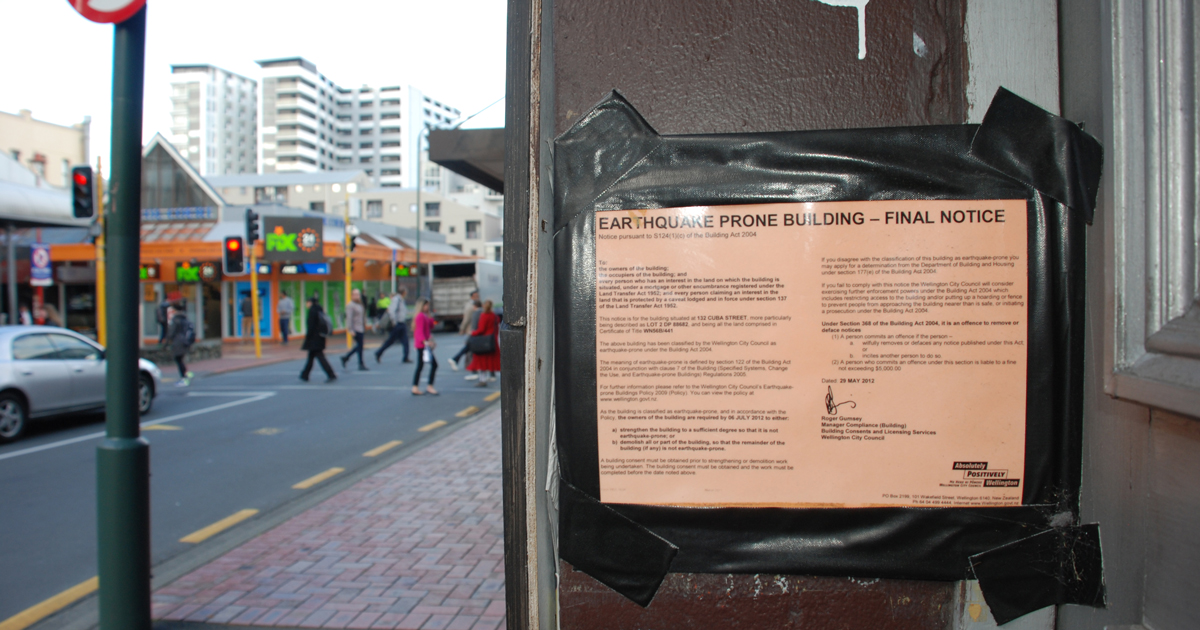Government shifts focus of earthquake-prone building rules
13 Oct 2025, Industry News, News, Regulatory

The Government has announced proposed legislative changes aimed at making the earthquake-prone building system more risk-based and proportionate by focusing on higher seismic risk areas and high-risk buildings
The Government is pressing ahead with a major reset of New Zealand’s earthquake-prone building (EPB) regime, shifting away from a blanket national standard and toward a risk-targeted model. The changes are designed to ease regulatory pressure on building owners in low-seismic risk areas while maintaining stringent requirements for buildings that pose the greatest threat to life.
Announced by Building and Construction Minister Chris Penk on 29 September, changes to how an EPB is defined will reduce the number of buildings classified as earthquake-prone
“The Government is removing the New Building Standard (NBS) percentage ratings currently used by engineers to determine whether a property is earthquake-prone,” said Penk.
“The NBS rates how an existing building is expected to perform in an earthquake compared to a new building and has proven [to be] too broad and inconsistent.”
Under the revised rules, all buildings in low-seismic risk zones – such as Auckland, Northland and the Chatham Islands – will be removed from the EPB framework entirely. The focus will instead fall on high- and medium-risk areas, where certain structural types, such as unreinforced masonry or older concrete buildings over three storeys, will remain subject to regulation.
“The current system places an overwhelming financial burden on owners of older buildings, many of which are important to our communities,” Penk said. “This is a common-sense shift that retains a focus on life safety while removing costly overreach.”
Industry response
Master Builders and Te Kāhui Whaihanga New Zealand Institute of Architects (NZIA) welcomed the announcement, praising the move to a risk-based approach that focuses on life safety while reducing unnecessary compliance.
“Removing the NBS percentage as the trigger for EPB status addresses a long-standing concern that an overly blunt tool was driving disproportionate costs and uncertainty,” the organisations said in a joint statement. “This is not an exact science. The same building can receive vastly different ratings depending on the engineer and methodology used.”
They said the revised approach rightly recognises that buildings in high-risk zones require different treatment to those in low-risk areas, noting that billions of dollars had previously been tied up in “unnecessary or disproportionate strengthening”.
The statement continued: “Focusing on genuine life-safety risks, including targeted retrofit for multi-storey concrete buildings and sensible treatment of unreinforced masonry, is a more practical way to prioritise the right work in the right places.”
The groups also welcomed longer timeframes and the decoupling of seismic and fire or accessibility upgrades.
“This will help unlock stalled projects while maintaining life-safety as the top priority,” they said.
They added that the industry had already shown leadership through seismic upgrades and resilient new builds that balanced structural soundness with heritage and design values.
“We welcome this announcement and look forward to working together to ensure the new system is implemented in a way that delivers both safety and quality outcomes.”
From percentages to real risk: NBS rating dropped
One of the most significant changes is the removal of the NBS percentage rating as the primary trigger for an EPB classification.
Instead, seismic risk will be assessed more directly based on building type, location and actual life-safety concerns:
- Unreinforced masonry buildings with unsecured façades and walls facing public areas or above neighbouring properties will automatically be deemed EPBs because of their risk profile, with no further assessment required.
- Concrete buildings of three storeys or more will be assessed for EPB status using a new targeted retrofit methodology focused on the critical vulnerabilities that can lead to collapse.
An independent review of the EPB system, released alongside the policy changes, found that the current system was laced with significant issues – including buildings being captured by the system that were not intended to be.
Fewer buildings, lower costs, longer timeframes
Modelling by MBIE suggests that the new framework will see approximately 55% of buildings currently listed as earthquake-prone removed from the register. A further 1,440 buildings will face lighter requirements. Only around 80 buildings in the whole country will require full seismic remediation under the revised settings.
Central Otago, including Dunedin, will move from a low to a medium seismic zone. This means the existing 150 EPBs in Dunedin will remain in the system, and more may be identified.
Under the current EPB system, buildings of particular usage, post-disaster significance or on major throughfares could be considered “priority buildings”, requiring remediation in shortened timeframes.
Under the changes announced, only unreinforced masonry that risks pedestrians or vehicles, and buildings that could block emergency routes, will qualify as priority buildings. Hospitals, fire stations and schools will no longer automatically be classified as priority, giving agencies more time to plan seismic upgrades.
Local councils will be able to issue deadline extensions of up to 15 years, allowing owners to spread the cost of strengthening work and co-ordinate more efficiently with insurers, tenants and lenders.
The Government will also remove the current requirement that fire safety or disability access upgrades be completed at the same time as earthquake strengthening. This change will allow more targeted investment and reduce the complexity of project delivery.
Following the introduction of a Bill to amend the earthquake-prone buildings provisions of the Building Act later this year, Select Committee hearings are planned for the first half of 2026. This will be the opportunity for people and organisations to have their say on the proposed changes.
An implementation (commencement) date of mid-2027 is anticipated.
Register to earn LBP Points Sign in



